
- Homepage
- Photo Type
- Album (5)
- Albumen (14)
- Ambrotype (190)
- Cabinet Photo (55)
- Cdv (390)
- Cdv & Tintype (6)
- Cdvs (3)
- Cdvs & Tintypes (7)
- Daguerreotype (75)
- Gelatin Silver (13)
- Mixed (3)
- Negative (10)
- Negative Photo (3)
- Opalotype (4)
- Photograph (3)
- Staged (2)
- Stereoview (23)
- Tintype (464)
- Tintypes (3)
- Unknown (11)
- ... (4522)
- Size
- Subject
- Children & Infants (19)
- Civil War (28)
- Civil War Soldier (10)
- Ethnic (17)
- Family (11)
- Fashion & Costumes (9)
- Figures & Portraits (141)
- Genealogy (10)
- Historic & Vintage (76)
- History (11)
- Men (45)
- Men, Civil War (37)
- Men, Military (29)
- Military (70)
- Military & Political (528)
- Military & War (12)
- Portrait (8)
- Portraits (14)
- Soldier (9)
- Women (12)
- ... (4710)
- Theme
- Americana (29)
- Americana, Art (4)
- Americana, Fashion (14)
- Americana, Militaria (14)
- Art (5)
- Celebrities (2)
- Civil War (13)
- Fashion (14)
- Fashion, People (2)
- History (27)
- History, Militaria (5)
- Militaria (536)
- Militaria, People (4)
- Patriotic (3)
- People (17)
- Politics (5)
- Portrait (43)
- Portrait, Man (18)
- Sports (3)
- Stamps (13)
- ... (5035)
- Type
- Unit Of Sale
Identified Civil War 35th Mississippi Confederate Infantry Ambrotype Grace Broth
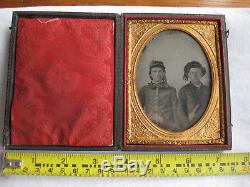
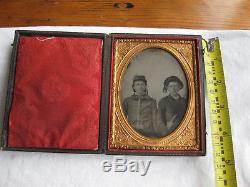
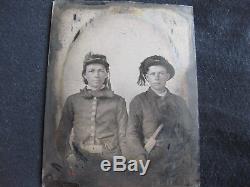

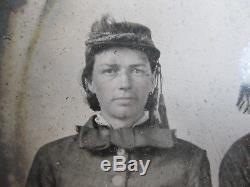

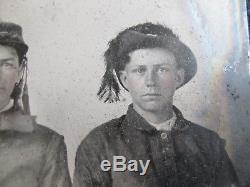
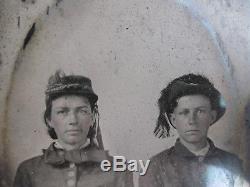
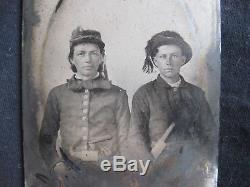





Identified Civil War 35th Mississippi Confederate Infantry Ambrotype of Grace Brothers. After retiring and downsizing I no longer have the available area to display them properly and I wish to pass these items on to someone who may have the room to display and appreciate them fully. This is a quarter plate clear ambrotype of two Confederate Brothers from Anson North Carolina who joined the 35th Mississippi infantry to fight with their relatives from that state two of which died in battle.
Joseph F Grace and John A. Joseph on the left, joined when he was 16 years old and Tom was 19 years old. Both can be seen with there bowie knives and pistols tucked in there belts along with wearing plumes in their hats. These two boys would participate in some of the hardest fighting in the Mississippi Theatre.
Joseph was captured outside of Atlanta during severe fighting at Allatoona Pass as Hoods Army tried a movement towards Chattanooga TN. If you have any questions or comments feel free to write me. 35th Infantry Regiment, recruited at West Point and Corinth, was organized during the spring of 1862.
The unit fought under General J. And lost 32 killed, 110 wounded, and 347 missing. Later it was assigned to Hebert's and Moore's Brigade, Department of Mississippi and East Louisiana, and in February, 1863, totalled 414 officers and men. It was captured when Vicksburg. Fell, and during the siege it had 20 killed and 82 wounded. After being exchanged, it was placed in Baldwin's and Sears' Brigade, served throughout the Atlanta.Campaign, was in Tennessee with Hood, and aided in the defense of Mobile. The regiment sustained 20 casualties at New Hope Church.
35 at the Chattahoochee River. And 47 in the Battle of Atlanta. It surrendered with the Department of Alabama, Mississippi, and East Louisiana. The field officers were Colonel William S. Berry, Lieutenant Colonels Charles R. This information is from the Southern Star of DeKalb, Mississippi Kemper Co.Printed on June 05, 1907 by C. It is the Roll for the 35th Mississippi Regiment Volunteers, Company B.
This Company was Enlisted and Organized on March 01, 1862. Jack, Captain; resigned April 1862. McAllister, 1st Lieutenant; died April 1862.
2nd Lieutenant; promoted to Captain April 1862; wounded at Corinth, Mississippi. Adams, killed at Corinth, Mississippi October 04, 1862. Blakely, killed at Franklin, Tennessee November 30, 1864. George Bannerman, elected 2nd Lieutenant April 1862.
Wounded at Corinth, Mississippi October 04, 1862 and at Franklin, Tennessee November 30, 1862. Joseph Black, Enlisted March 1st, 1862. He was Captured December 17th, 1864 at Franklin, Tenn. He was Later Released June 12th, 1865 at Camp Chase, Ohio.
Lot Ballard, killed at Vicksburg, Mississippi 1863. Cherry, killed at Kennesaw Mountain, January 1804 (probably means 1864). Marion Carter, wounded at Casseville, Georgia. Carpenter, wounded at Atlanta, Georgia.Davis, wounded at Kennesaw Mountain, and at Blakeley, Alabama. Edwards, wounded at Corinth, Mississippi.
Napoleon Edwards, died in prison. Felton, elected 3rd Lieutenant 1864, wounded at Blakeley, Alabama. Flake, wounded at Altoona, Georgia. Hamp Grace, killed at Corinth, Mississipp.Gary, killed at Atlanta, Georgia. Hailey, killed at Corinth, Mississippi. John Kerr, elected 1st Lieutenant 1862, wounded at Corinth, Mississippi.
Jessie Long, elected 3rd Lieutenant 1863, killed at Atlanta, Georgia August 1864. Bryant Lam, wounded at Atlanta, Georgia. Hendon Morris, killed at Atlanta, Georgia.
John McLaurin, wounded at New Hope, Georgia. Newell, wounded at Corinth, Mississippi.
George Oden, wounded at Blakeley, Alabama. Steve Parish, wounded at Corinth, Mississippi. Rainey, killed at Corinth, Mississippi. Jessie Rowe, wounded at Corinth, Mississippi. Aron Rosenbaum, killed at Kennesaw Mountain.
Sanders, wounded at Corinth, Mississippi. Hiram Stokes, killed at Atlanta, Georgia. Furman Treadaway, killed at Manita. Bill Wilson, killed at Corinth, Mississippi.
Side Note: Anderson Earp, died Corinth, Mississippi of disease May 08, 1862. From Dunbar Rowlands Military History of. Grady Howells For Dixie Land, Ill Take My Stand. Company A -- Barry Guards (raised in Kemper County, MS). Company B -- Farmer Boys (raised in Kemper & Winston Counties, MS).Company C -- Oktibbeha Rescue No. 2 (raised in Lowndes & Oktibbeha Counties, MS). Company D -- Fort Donelson Avengers (raised in Winston County, MS). Company E -- Muckalusha Guards, aka Neshoba Dixies (raised in Neshoba County, MS).
Gregorys Company (raised in Lowndes County, MS). Coopwoods Company (raised in Chickasaw, Lowndes, & Oktibbeha Counties, MS). Company H -- Confederate Volunteers (raised in Lowndes County, MS). Watsons Company (raised in Lowndes County, MS).Company K -- Invincible Warriors (raised in Chickasaw, Choctaw, Lowndes, & Oktibbeha Counties, MS). No muster rolls in this department. The regiment was organized at West Point in March, 1862, and while the army, under General Beauregard, occupied Corinth it was assigned to Gen. Moore's Arkansas and Texas Brigade, Maury's Division.
Corinth was evacuated May 29, and the main body of the Confederate forces was taken by General Bragg to Chattanooga in July, leaving the Army of West Tennessee, under General VanDorn, along the line of the Central Railroad, and the Army of the West, under General Price, in Northeast. Maury's Division, including the Thirty-fifth, was a part of Price's army, and was encamped at Guntown early in September. On the 12-14 of that month Price advanced and occupied Iuka, while VanDorn moved toward Grand Junction, the purpose being to prevent reinforcements being sent from Grant's command in West Tennessee and North. To Buell, as Bragg was moving toward Louisville, Ky. Grant set his forces in motion toward Iuka, and one column, moving from Burnsville, skirmished with Maury's Division September 16, an action in which the Thirty-fifth had some part.The skirmish was renewed on the 18th by the Federal troops at Burnsville, covering the movement which Grant arranged in the hope of capturing the entire Confederate force. Rosecrans attacked Hebert's Division at Iuka on the 19th, but Grant's plans were defeated by the desperate fighting of the Texans and Mississippians with Hebert, and the strange fact that General Ord at Burnsville did not hear the grins at Iuka. After this Price and VanDorn united and made an attempt to surprise and capture the forces at Corinth under Rosecrans.
The Thirty-fifth participated in the attack at Corinth, October 3-5, 1862, and the regimental casualties were 32 killed, 110 wounded and 347 missing. With Moore's Brigade the regiment took part in carrying the outer line of rifle pits on the 3d, approaching which one company of the Thirty-fifth, on the skirmish line, was the first engaged. The rifle pits were carried without serious opposition; the brigade pushed on and again encountered the enemy and drove them from their position after a short but severe engagement. The brigade was advancing along the north side of the Memphis and Charleston Railroad, but was annoyed by a Federal battery on a hill south of the road. This hill they moved against and charged in the face of the.Fire of two lines, the artillery being removed at their approach. The position and camp were carried in fine style. About dark the brigade was posted on a hill in sight of the town of Corinth, and early in the morning of the 4th it was put in the line of assault between the brigades of Cabell and Phifer. When it appeared that Hebert's position was attacking on the left, Moore advanced, and was almost immediately greeted by a concentrated fire of artillery, "the severest fire, " said Moore, I ever imagined possible to concentrate on one point in front of a fortification. But they suffered little from it, in the forest, until they reached the fallen timber and open space in front of the works.
"On reaching this point, " said Moore, we charged and carried the enemy's works the whole extent of our line and penetrated to the very heart of Corinth, driving the enemy from house to house and frequently firing in at the windows and driving them out. But they were soon overwhelmed by superior forces, and being without support and in disorder from the circumstances of the assault, were compelled to retire. This experience was not so trying, however, as that encountered at Davis' bridge across the Hatchie, on the retreat.
The brigade was the advance guard, and exhausted by hard service and hunger not more than 300 were in the ranks. They were instructed to cross the bridge and occupy Metamora Heights, which command the bridge, but on reaching that position found the hill occupied by a strong Federal force with artillery, sent to cut off the Confederate retreat. Moores command made a gallant fight but were driven back across the river with heavy loss. General Moore said: It is impossible to make an accurate report of the killed, wounded and missing in battle, as the Thirty-fifth dispersed after the fight at Davis' bridge, there being now present but some forty men and one line officer, Lieutenant Henry. From the best information we can obtain we are assured that many of the officers and men have gone to their homes.This conduct on their part is astonishing and unaccountable, for the regiment acted nobly and did good service during the three days' fighting. It is to be regretted that its commander, Colonel Barry, was not present on the 5th, he having been sent to Corinth under a flag of truce to bury the dead.
He is a gallant and efficient officer, of whom his State may well be proud. The next campaign of the regiment was Grant's advance on the Central Railroad in November and December, 1862. In January, 1863, the regiment was reported 414 effective present. January 2, the regiment reinforced Colonel Withers at Blake's levee, north of Vicksburg, at the close of the Chickasaw Bayou battle. March 12 General Moore was ordered to Snyder's Bluff with the Thirty-fifth and Fortieth Regiments, to take boat for Yazoo City.
The brigade served at Fort Pemberton, near Greenwood, during the remainder of March, holding in check the expedition down Yazoo Pass, then navigable on account of high water from the. The fighting was mainly between the land batteries and gunboats, until the 20th, when an expedition was made up the Tallahatchie, after which a force of. Was landed near Fort Pemberton. On account of the overflow the. Maury was in command of the forces at Cureton's.April 1st the enemy began the construction of a battery. During the 2d, 3d and 4th a heavy fire of artillery was kept up upon this work, and sharpshooters were sent to annoy the workmen. Maury attacked on the 4th and the enemy embarked and departed. S Brigade, during the battles of Baker's Creek and Big Black bridge, guarded the river front at Warrenton and the approaches from the lower ferries on the Big Black River, after which the brigade was drawn in at once and placed in the intrenchments on each side of the Baldwin's Ferry road. There they sustained and repulsed determined assaults on May 22.
From that time till the close of the siege (forty-seven days) the men were confined to the trenches night and day under a fire of musketry and artillery, which was often kept up during the whole night as well as the day. General Moore wrote: Some idea may be formed of the artillery fire to which we were exposed when I state that a small party sent out for that purpose collected some two thousand shells near and in the rear of the trenches occupied by our brigade. This was soon after the siege began and was but a portion of those that failed to explode. Toward the end of this service, the men were exhausted both in mind and body. They had been forty-seven days in a narrow ditch, exposed to scorching heat during the day and the often chilling air and dews of night.
To the inquiry July 2, regarding the possibility of cutting a way out, Colonels Barry and Colbert joined in the reply that the men were incapable of the effort. The casualties of the Thirty-fifth during the siege were 3 officers Captains S. Moody and 17 enlisted men killed, 4 officers and 78 enlisted men wounded. The brigade included the Thirty-seventh, Fortieth and Forty-second Alabama, Second Texas, Sengstak's and Tobin's Batteries and a pioneer company. The brigade had 121 killed and surrendered 4,368.
Jordan paroled as commanding officer. November 20 Baldwin's Brigade, including Fourth, Thirty-fifth, Thirty-ninth, Fortieth and Forty-sixth Regiments, was reported 2,279 exchanged and armed, including the Thirty-fifth, organizing at Columbus. The brigade was ordered to Atlanta November 21 to reinforce General Bragg, but the battle of Missionary Ridge was fought before they could reach that field. The brigade was made part of W. Maury sent them to Meridian to reinforce Polk February 7, and Polk being on retreat to Demopolis before Sherman, sent them back to Mobile, where they remained until re-transferred to Polk's department, arriving at Selma April 13.
The brigade after April 1 was under command of Brigadier-General Sears, formerly Colonel of the Forty-sixth, Colonel W. The brigade joined the troops under General Johnston as Resaca was being evacuated, May I6, and thereafter French's Division, of which it was the largest of the three brigades, was under fire every day but one until September 6. On account of the sickness of General Sears, Colonel Barry was most of the time in command of the brigade. He was commended for his services at the battle of Kenesaw Mountain, July 27, when whatever credit that was due for the repulse of the assaulting column on the front of French's Division, belonged exclusively to Cockrell's Missourians and the left of the line of Barry's Mississippians (Frenchs report). The line was under fire of fifty-one pieces of Federal artillery. In the battle of Peachtree Creek Barry and the brigade was to have supported Walthall in a flank attack which might have won the battle, but it was dark before they had an opportunity to become effective. They took position on the Turner's Ferry road west of Atlanta July 21, and were there constantly engaged in defense of the line and fortifying for more than a month. August 6 the regiment, under Lieutenant- Colonel Shotwell, advanced on reconnaissance and took position in the enemy's vacated picket line, losing 1 killed. On the 12th the regiment being on picket under command of Lieutenant-Colonel Shotwell, the vedettes were driven back by a superior force, the regiment losing 5 killed, 5 wounded, 4 missing. On August 27 they marched out in reconnaissance to the position of the Twentieth Corps on the Chattahoochee River.They were the rear guard at the evacuation of Atlanta, September 1. The casualties of the regiment were, at Cassville, 2 wounded, 2 missing; New Hope Church, 6 killed, 9 wounded, 5 missing; Kenesaw Mountain, 6 killed, 27 wounded, 3 missing; Smyrna, 1 killed, 2 wounded, 28 missing; Chattahoochee, 15 wounded, 20 missing; Atlanta siege, 7 killed, 34 wounded, 6 missing; Lovejoy's Station, 1 wounded, 6 missing. Total, 20 killed, 90 wounded, 70 missing, which was the heaviest in the brigade. Early in October, 1864, when Stewart's Corps (Army of Mississippi) was destroying the railroad north of the Chattahoochee, as part of Hood's movement toward Chattanooga, General French was ordered to take the Federal post at Allatoona Pass. The works, three redoubts and a star fort, were held by General Gorse and about 2,000 men, in communication by signal flags with General Sherman on Kenesaw Mountain.
After a night march General French attacked, sending Sears' Brigade to the north and rear of the works, Cockrell and Young to attack in front with Myrick's Artillery Battalion. Sear' attack fell upon both the redoubts and the fort. The fighting was fierce for over three hours, after which General French withdrew his troops, Federal reinforcements being dangerously near.
General Gorse with three regiments met the attack north of the redoubts, and, as he reported, the enemy's line of battle swept us back like so much chaff. Fortunately for us, Toutelotte's fire (from the star fort) caught Sears in the flank. It was only by a hand to hand struggle that Corse was able to bring a man back into the redoubt. Sears' men pushed up, taking shelter behind stumps and logs and trenches, and swept the redoubt with a deadly fire, but the Federal artillery managed to make an assault impossible.
It was one of the most desperate and famous battles of the war. Corse reported 142 killed, 352 wounded, 212 missing, out of 1,944 engaged. We buried 231 rebel dead and captured 411 prisoners (including General Young), three stands of colors and about 800 stands of arms. Major Edson, Fourth Minnesota, reported that his position was desperately charged upon by two Confederate regiments, which were forced back except small detachments of each that pushed forward and took shelter in a narrow ravine, where he captured eighty prisoners, including one field and several line officers, with the colors of the Thirty-fifth and Thirty-ninth Mississippi infantry. " Including the capture of the blockhouse at the bridge by Colonel Adaire, French reported the capture of 205 prisoners, two stand of colors, and his loss 122 killed, 443 wounded, 223 missing, out of a "little over 2,000 men. Among the wounded were Colonel Barry of the Thirty-fifth, in which regiment the casualties were 12 killed, 52 wounded, 83 missing.Killed in brigade -- Capt. French's Division captured the blockhouse at Tilton, Ga. October 13, and next encountered the enemy at Decatur, Ala.
October 26-29, moving thence to Tuscumbia. They crossed the Tennessee River November 20 and marched against Schofield's Federal command at Columbia. November 29 Stewart's Corps (Loring's, French's and Walthall's Divisions) moved toward Spring Hill to support Forrest and Cheatham in cutting off Schofield's retreat, but confusion in a night march prevented their going into action, General Hood afterward wrote to General Stewart: I only regret, General, that I did not have you with your corps in front that day.I feel, and have felt, that Tennessee today would have been in our possession. November 30 Stewart's Corps followed closely upon Schofield as he retreated to a very strong defensive position in front of Franklin, on the Harpeth River. The attack began about four in the evening and was kept up until midnight, but though the first line was easily carried, the assault against the second line, across an open space swept by a crossfire of artillery, failed with a terrible loss of life. The following of the Thirty-fifth, among others of the brigade, "the foremost of the forlorn hope, " reached the second line, and remained there through the night, and until Schofield withdrew: Company A -- Corporal James M.
Company D -- First Lieutenant J. Company E -- Captain J.Company F -- Sergeant W. Company I -- Sergeant A.
The following reached the abatis: Company A -- First Lieutenant J. Company D -- Corporal W.
Company E -- Second Lieutenant J. Company K -- Privates A. Harrington, Munroe Watson wounded three times near. The casualties of Sears' Brigade were 3o killed, 168 wounded, 35 missing. The remnant marched to Nashville, and were detached from French's Division to march with Bate's Division to support Forrest in the siege of Murfreesboro.
At Overall's Creek, December 4, the brigade had 21 killed and wounded. They were in battle before Murfreesboro December 7. A return of the brigade of five regiments, dated December 9.
Shows 2,306 on the roll, of which 496 were prisoners, 396 present and 210 effective. This fragment of a brigade took part in the battle before Nashville December 15-16. Major- General Walthall reported that about dark on the 15th, when the troops of the corps had been collected to the right of the Granny White pike, Sears' Brigade, commanded by Lieut. Shotwell, numbering not more than 150 men, was temporarily attached to his command. Hood's army crossed the Tennessee River December 26, and headquarters were established at Tupelo. French's Division was ordered to report to General Maury at Mobile, February 1, 1865. The return of March 10 showed Sears' Brigade commanded by Col.Adair, the Thirty-fifth Regiment commanded by Capt. The last service of the regiment was atish Fort and Fort Blakeley, west of the bay, attacked by the Union troops under General Canby, where there was severe fighting along a battle line of seven or eight miles in March and April, 1865.
Finally the fortifications were carried by assault, the final action being at Fort Blakeley April 9, and about 5,000 Confederate soldiers were taken prisoners, among them the remnant of the Thirty-fifth Mississippi. They were paroled after the capitulation of Lieut. Richard Taylor, commanding the department, at Citronelle, Ala. Please view photo's for condition and make your own judgement to the condition of this item. Please see my other Civil War Items that I have listed. The item "Identified Civil War 35th Mississippi Confederate Infantry Ambrotype Grace Broth" is in sale since Wednesday, January 17, 2018. This item is in the category "Collectibles\Militaria\Civil War (1861-65)\Original Period Items\Photographs". The seller is "ke1sean" and is located in Sparta, North Carolina. This item can be shipped to United States.- Country/Region of Manufacture: United States

